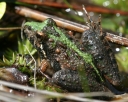Southern Cricket Frog (Acris gryllus)
Description: Subspecides Acris gryllus gryllus 1has a small body about 0.6 to 1.25 inche long, a tapered snout, and anal warts. The head is pointed and has a dark triangle between the eyes. A light bar extends from the eye to the forelimb. The thigh is marked by a clean, dark stripe surrounded by distinct light stripes.
The other subspecies Acris gryllus dorsalis is similar in size and appearance to A. g. gryllus, except that it has no anal warts and the rear of its thigh is marked by two dark lines. Males have a grayish chest and throat with a round vocal sac. These body areas are usually more spotted in males than females.
Habitat: The southern cricket frog is characteristic of coastal plain bogs, bottomland swamps, ponds, and ditches. It prefers sunny areas, and is usually not found in woodlands.
Range: Subspecies Acris gryllus gryllus is found in the Atlantic Coastal Plain from southeastern Virginia through the Carolinas, Georgia, Alabama, and Mississippi, west to the Mississippi River. It is found mostly east of the Fall Line, but extends into more upland areas of the Piedmont along river valleys. Range Map
Subspecies Acris gryllus dorsalis is found throughout the Florida peninsula. Range Map
Diet: Adult southern cricket frogs are insectivorous and eat mostly mosquitoes. They attempt to catch prey by jumping forward and reaching with their tongues, sometimes even chasing after prey. In the tadpole stage, cricket frogs feed on plants.
Reproduction: Breeding occurs in the water. Females lay eggs one by one and attach them to the rocks and the vegetation of pond bottoms. Eggs are dark brown or black with a tan colored bottom. Tadpoles develop to be 1/2 inch long after about 7-13 weeks. At this point, they are deep-bodied with a lower labium, indentations of a mouth, eyes, and an anus. They are distinguished by a distinct black tipped tail.
A. g. gryllus breeds from February to October, depending on rainfall, while A. g. dorsalis can breed during any month.
Status: Secure or Apparently Secure In all of its range with the exception of Tennessee which has it classified as Imperiled.
»» Kingdom: Animalia - Animals
»» Phylum: Chordata - Chordates
»» Subphylum: Vertebrata - Vertebrates
»» Class: Amphibia - Amphibians
»» Order: Anura - Frogs & Toads
»» Family: Hylidae - Treefrogs
»» Genus: Acris
»» Species: Acris gryllus - Southern Cricket Frog
»» Subspecies:
Florida Cricket Frog - Acris gryllus dorsalis
Coastal Plains Cricket Frog - Acris gryllus gryllus
This article uses material from the Wikipedia article "Southern Cricket Frog", which is released under the Creative Commons Attribution-Share-Alike License 3.0. Content may have been omitted from the original, but no content has been changed or extended.
|







